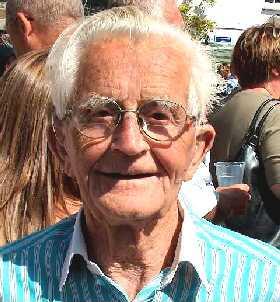Memories of St Keverne Working Men's
Club
by Billy Moyle
 As the only surviving founder member
of St-Keverne Working Men's Club and now aged
94, I thought that I would write down a few
memories about the club and clubroom.
As the only surviving founder member
of St-Keverne Working Men's Club and now aged
94, I thought that I would write down a few
memories about the club and clubroom.
In the immediate years after the First World War, there were few employment opportunities in the St Keverne area, as was the case in most villages on the Lizard Peninsula. The main employers in the area were the two stone quarries at Porthoustock and the Dean but these offered jobs for quarrymen rather than for youngsters. Local farmers could offer seasonal work especially at harvest time on threshing days and always gave farm produce in addition to wages.
There was very little in the way of social life for young people apart from activities connected with the church or the chapel. The only hall available in the village to possibly house a men's club was the Parish Hall, known as the Reading Room and several attempts were made by various people to use it as a clubroom. However, the late Sir Courtnay Vivyan thought that such a use would upset the elderly folk who used the hall as a quiet reading room.
In 1922 a new Methodist minister was appointed for the St Keverne Circuit - the Rev.Joseph Birkbeck moved into the Manse with his family which included three sons. Rev. Birkbeck soon became aware of the problems facing the young men in the village and was instrumental in persuading the Chapel Trustees to allow him to start a club in the Sunday School Room known as the Ark. By January 1923 Rev Birkbeck was able to report back to the trustees that a working men's club had been successfully established in the Ark. (St Keverne band had been using the Ark for band practice since 1910 so this building served as a band room, a club room, a Sunday School and the home for chapel activities). The Ark on a late Saturday evening had to be got ready by the young men for Sunday School the next day.
As time went by the club began to outgrow the Ark and a search was always being made about a possible new site. I forget the year but Mr Rogers who had farmed at Trythance retired to the village and he owned a building in Trelyn Lane that was an old stable. Bill and Peggy Tripp who ran the daily St Keverne - Helston horsebus used to keep their horses there. Eventually, after discussions between the Rogers family and the club officials, the old stables were pulled down and the site prepared for the building of a new clubroom.
The work was undertaken by local volunteers which included several masons and I remember the concrete blocks being made in their thousands in the yard in Trelyn Lane. Mr Sandy Hill of St Keverne and Mr Jack Hayden were in charge of the block-making. I reckon at least two thousand blocks were made! At the same time as this was happening fund raising events were being organised in the village to meet the expenses.
My late brother Hugo Moyle of St Keverne and later of Garras was the guest billiard player at the opening ceremony of the new Working Men's Club-room in 1941. Hugo had been taught how to play billiards at the age of eight by Mr Ralph Clayton, the headmaster of St Keverne School. This would have been in about 1907 or 1908 (even before I was born). Hugo, despite his short stature, was an excellent billiards player and during his years in St Keverne was the organiser of a billiards team and was responsible for arranging visits by teams from other places on the Lizard peninsula and for organising tournaments.
For many years Dorothy (Dolly) Williams was caretaker of the clubroom - she was responsible for cleaning the place and lighting the fire. Dolly retired sometime in the 1960s and received a presentation at a special "do". Names come back to me of some of the people present on that occasion (apart from myself) - Roy Pascoe from Treskewes, Jack and John Williams (Dolly's husband and son), Dennis Treloar, Morely Thomas, Dick Nicholls, Keith Sobey, Rex Williams from the Post Office, Geoffrey Rogers from Rosenithon, Derek Keverne, David Rogers, Colin Retallack, Edward Rogers (Treglohan) and Jimmy Rogers (Lower Treglohan).
Apart from a short period of time (in the early 1950s I think) the clubroom has been in continuous use and generations of St Keverne young people have taken advantage of the facilities offered. The billiard table filled the centre of the main room but there was always space for a game of cards either in the main room itself or in the small anteroom. The good thing about St Keverne WMC was the fact that teenagers and the retired mixed extremely well and the "older" members were always happy to play the youngsters at billiards, snooker or in a game of cards. My son Terry remembers using the WMC regularly during his late teenage years with all his friends (late 1950s/early 1960s) and my grandson Tristan also had a game of snooker there when he was a young lad and experienced a full size table for the first time! I am proud to be have been associated with St Keverne clubroom for most of my life.
Billie Moyle - March 2005.